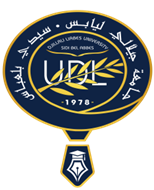Browsing by Author "Encadreur : Bousmaha-Marroki Leila"
Now showing 1 - 2 of 2
Results Per Page
Sort Options
- ItemContribution à l’étude des caractères physico-chimiques et microbiologiques des fromages produits en Algérie(2020) KEBIBI Nezha Douniazed; Encadreur : Bousmaha-Marroki LeilaRésumé : ( Français ) L’Algérie se distingue par plusieurs variétés de fromages traditionnels parmi eux, le Jben, et le Kemariya qui ont fait l’objet de notre étude. Une analyse physicochimique (détermination du pH) et des analyses microbiologiques (recherche des Staphylococcus aureus, des germes sulfito-réducteurs, levures, moisissures, coliformes et streptocoques fécaux) ont été réalisées sur les trois fromages pris dans deux régions rurales, Marhoum (commune de la Wilaya de Sidi Bel Abbes) et Mécheria (Commune de la Wilaya de Naàma). Les résultats de la détermination du pH ont montré que ces trois fromages sont acides, le fromage Jben a un pH de 4,1, le fromage Kemariya 1 a un pH de 4,6, et le fromage Kemariya 2 a un pH de 4,9. L’étude microbiologique a révélé l’absence de germes anaérobies sulfito-réducteurs, coliformes et streptocoques fécaux sur les trois échantillons de fromages. La recherche des Staphylococcus aureus a révélée leur présence dans l’échantillon de Jben et de l’échantillon 2 du fromage de type Kemariya. Par la recherche de la flore mésophile totale, nous avons obtenu une gamme de colonies de taille variable, de couleurs différentes et de différentes formes, montrant une diversité microbiologique. Toutes les boites de pétri de la recherche de la FMAT des différents fromages sont indénombrable. L’ensemble des résultats de recherche des levures et des moisissures sur les différents fromages analysés ont été soit non dénombrables pour raison de la quantité insignifiante, soit une absence totale de colonies des levures et moisissures sur les boites. L’isolement et l’identification des bactéries lactiques des fromages traditionnels étaient prévue. Cette partie n’a pas pu être réalisée à cause de la crise sanitaire liée à la pandémie Covid-19. Mots clés : Jben, Kemariya, Fromages traditionnels, Analyses physicochimiques, Analyses microbiologiques. Abstract : ( Anglais ) Algeria is distinguished by several varieties of traditional cheeses among them, the Jben, and the Kemariya which were the subject of our study. Physicochemical analysis (determination of pH) and microbiological analyzes (search for Staphylococcus aureus, sulfite-reducing germs, yeasts, molds, coliforms and faecal streptococci) were performed on the three cheeses taken in two rural regions, Marhoum (municipality of the Wilaya of Sidi Bel Abbes) and Mécheria (Municipality of the Wilaya of Naàma). The results of the pH determination showed that these three cheeses are acidic, Jben cheese has a pH of 4.1, Kemariya 1 cheese has a pH of 4.6, and Kemariya 2 cheese has a pH of 4.9. The microbiological study revealed the absence of sulfite-reducing anaerobic bacteria, coliforms and faecal streptococci on the three cheese samples. Research for Staphylococcus aureus has revealed their presence in the sample from Jben and sample 2 from Kemariya – type cheese. By searching for the total mesophilic flora, we obtained a range of colonies of varying size, different colors and different shapes, showing microbiological diversity. All the Petri dishes in the research of the FMAT of different cheeses are uncountable. All the results tests for yeasts and molds on the different cheeses analyzed were either not countable due to the insignificant quantity, i.e. a total absence of colonies yeasts and molds on the boxes. Isolation and identification of lactic acid bacteria traditional cheeses were provided. This part could not be completed due to the health crisis linked to the Covid-19 pandemic. Keywords: Jben, Kemariya, Traditional cheeses, Physicochemical analyzes, Analyzes microbiological.
- ItemEffet antimicrobien des extraits de Retama dasycarpa et Thymelaea hirusta récoltées de la région de Djelfa(2020) BELGACEM Hanane; Encadreur : Bousmaha-Marroki LeilaRésumé : ( Français ) Ce travail consiste à caractériser l’extrait végétal aqueux de Retama dasycarpa, et Thymelaea hirsuta plantes spontanées de Djelfa. Le matériel végétale est récolté séché et broyé en poudre afin d’augmenter le rendement en métabolites secondaires. Les résultats de rendement d’extrait aqueux de Retama dasycarpa, et Thymelaea hirsuta sont de l’ordre 0,93% et 1,74% respectivement, ce qui indique que la Thymelaea hirsuta est plus rentable que Retama dasycarpa. Le screening phytochimique qui a révélé la présence des flavonoïdes, des tanins, et des saponines. Retama dasycarpa renferme également un faible taux de coumarine tandis que Thymelaea hirsuta s’est révélée exempte de cette famille de composés. L’évaluation de l’effet antimicrobien des extraits obtenues à partir de Retama dasycarpa, et Thymelaea hirsuta été envisagé dans cette étude. Les microorganismes ciblés étaient Pseudomonas aeruginosa et Staphylococcus aureus, deux espèces bactériennes pathogènes opportunistes. Cette partie n’a pas été réalisée par le fait de la crise sanitaire liée à la pandémie du Covid 19. Mots clés : Extraits végétaux, screening phytochimique, Retama dasycarpa, Thymelaea hirsuta, pouvoir antimicrobien, Pseudomonas aeruginosa, Staphylococcus aureus. Abstract : ( Anglais ) This work consists in characterizing the aqueous plant extract of Retama dasycarpa, and Thymelaea hirsuta spontaneous plants of Djelfa. The plant material is harvested, dried and ground into a powder to increase the yield of secondary metabolites. The aqueous extract yield results of Retama dasycarpa, and Thymelaea hirsuta are in the order of 0.93% and 1.74% respectively, indicating that Thymelaea hirsuta is more profitable than Retama dasycarpa. Phytochemical screening which revealed the presence of flavonoids, tannins, and saponins. Retama dasycarpa also contains a low level of coumarin while Thymelaea hirsuta has been shown to be free from this family of compounds. The evaluation of the antimicrobial effect of extracts obtained from Retama dasycarpa, and Thymelaea hirsuta was considered in this study. The target microorganisms were Pseudomonas aeruginosa and Staphylococcus aureus, two opportunistic pathogenic bacterial species. This part was not carried out due to the health crisis linked to the Covid 19 pandemic. Keywords: Plant extracts, phytochemical screening, Retama dasycarpa, Thymelaea hirsuta, antimicrobial power, Pseudomonas aeruginosa, Staphylococcus aureus.
